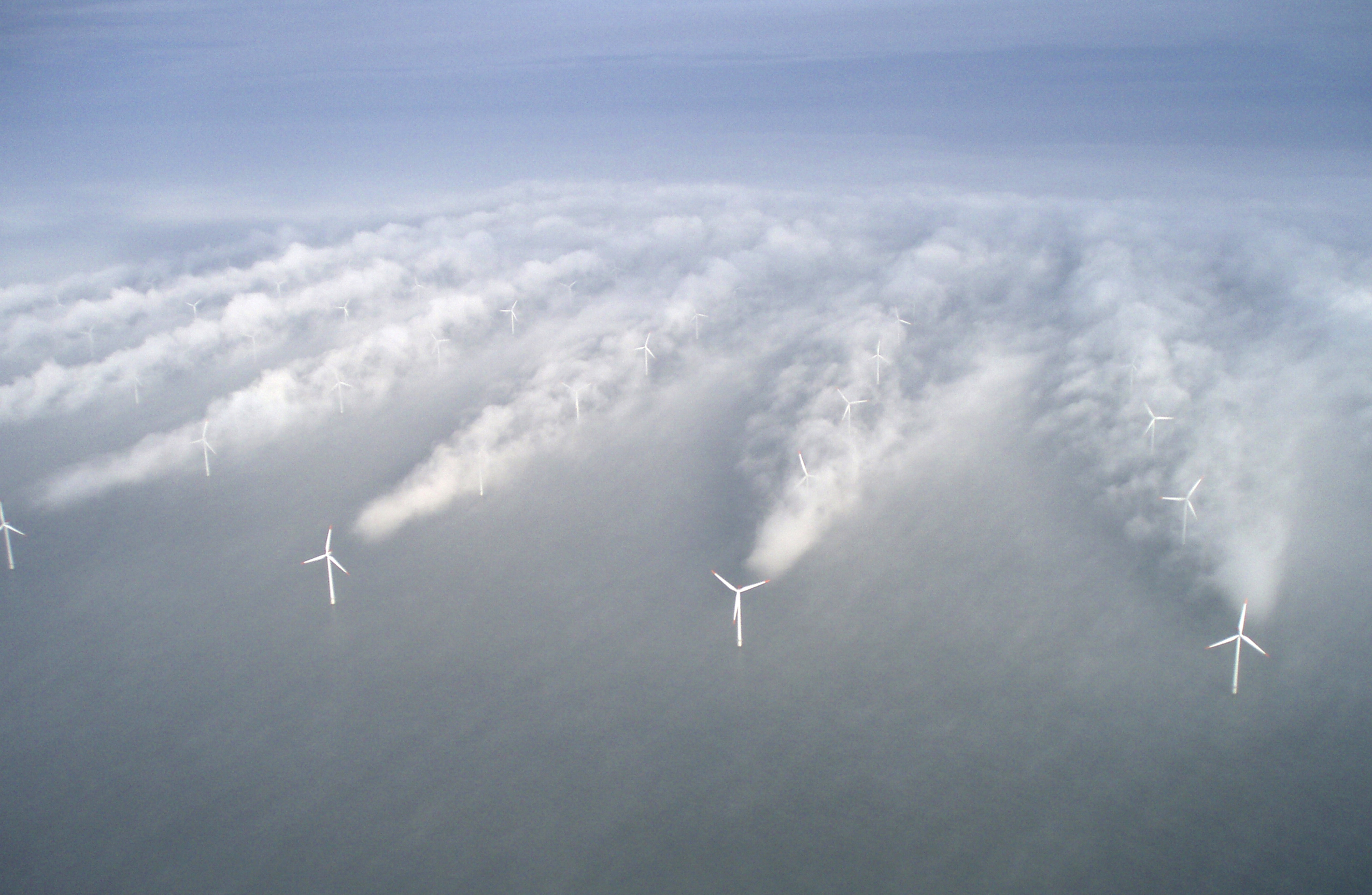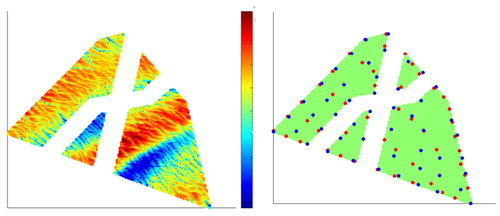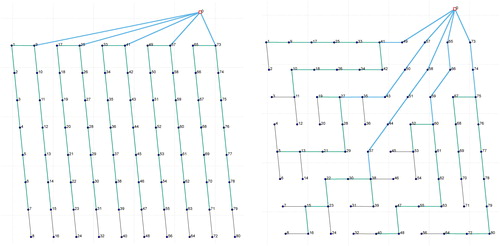
WIND ENERGY IS A FAST-EVOLVING FIELD that has attracted a lot of attention and investments in recent decades. Being an increasingly competitive market, it is very important to minimise establishing costs and to increase production profits already in the design phase of new wind farms. Therefore, Vattenfall, which is a leader in the wind energy business, uses state-of-the-art Operational Research (O.R.) techniques in the design phase of new offshore farms. Our work proved that millions of euros can be saved in practice by a smarter use of resources through the use of proper optimisation tools compared to the traditional and more manual approach.
If, during the last time you were flying, you were lucky to fly in clear weather over the ocean, you may have passed over an offshore wind farm and admired the turbines – all neatly arranged in long straight rows, symmetric from all angles. But you will see less of that in the future, as lining up turbines is most often really bad for performance because turbines will almost inevitably be casting wind shadows on other turbines in the farm, as can be seen in the lead image. In the future, you will see a new kind of 'beauty'– drawn by math and optimised in production.
Vattenfall uses state-of-the art Operational Research techniques in the design phase of new offshore farms
THE IMPORTANCE OF MINIMISING INTERFERENCE BETWEEN TURBINES
If we imagine two turbines placed one in front of the other along a certain wind direction, it is easy to imagine that the upwind turbine will screen the downwind turbine off from the wind. From a wind energy production perspective, this is a big loss, as the second turbine cannot produce as much as it would have done with unhindered access to the wind. We want all wind turbines to be clear of any wind shadow, the so-called wake effect, which could take away part of their capacity to generate electricity.
Obviously, if you have to place two turbines near each other, and you have only one wind direction, it is not that difficult to avoid them casting shadows on each other. But if you are asked to place 50 or 80 wind turbines in a wind farm site where the wind changes continuously, how will you then find the optimal location for all turbines?
Only a few years ago, the engineers at Vattenfall had to use standard commercial tools and, not least, their own experience to position turbines in a wind farm. These tools were not able to incorporate all the limitations and constraints in the design work, so quite a substantial amount of manual engineering work had to be done.
Now we use state-of-the-art Operational Research techniques to design modern wind farms. The question of optimal turbine allocation was addressed in a Ph.D. project and the resulting tools were fine-tuned in production mode at Vattenfall. New Operational Research models and algorithms were developed to optimise the position of wind turbines in a wind farm as well as the type and routing of cables to connect them.
WIND FARM LAYOUT: A CHALLENGING DISCIPLINE
Before Vattenfall starts its design work, it is given a pre-defined area offshore and all the relevant information about it, including wind statistics, sea bed conditions and various limitations such as ship wrecks, existing cable routes, etc. A team of experts in the company preselects a turbine model that they want to use on the site and, based on the overall capacity of the site allowed by the grid operator, they define how many turbines they want to install. At this point all the ‘LEGO bricks’ are there, but the biggest challenge remains: how should they be put together to create the best layout where all factors are taken into account? How should all the statistical information be used to increase production and profitability?
The optimisation is challenging. On the one hand, the magnitude of the instances in real-world applications is typically very large. On the other hand, there are some uncertain parameters such as wind conditions that are typical of stochastic problems. Finally, a number of non-linear effects have to be taken into account in the definition of the problem. Amongst these, the most relevant is the interaction between turbines.
An ad-hoc mathematical model was designed in Vattenfall to crack the nut and design a farm where the total power production was maximised (explicitly considering the wake effect), whilst all the constraints arising in practical applications were taken into consideration.
Our layouts proved to be, on average, about 10 million euros more profitable for each wind farm
Our layouts proved to be, on average, about 10 million euros more profitable for each wind farm. In , we illustrate an example of optimisation of a real-world farm. The costs of foundations (different colours in the plot on the left) are explicitly considered in our optimisation. Experts in Vattenfall compared our layout (red dots in the plot on the right) with the one obtained with the traditional process (blue dots), proving savings in the order of 12.6 million euro in the farm’s lifetime through increased production and reduced cost of foundations.
CABLE ROUTING TAKING A NEW DIRECTION
Once the turbine positioning is defined, the next step in the wind farm design process is to optimise the way they are connected through cables.
The turbines are connected through lower voltage cables to one or more offshore substations (the inter-array cable connection), and a unique high-voltage cable (the export cable) is used to transport the electricity from the substation to shore, where the grid transports the power to the end-customers. The challenge of optimising the inter-array cable routing lies in the decision of how to connect the turbines and what kind of cable to use for the connection.
The optimiser is provided with a set of possible cables, each of them characterised by different price per metre, different capacity and different electrical characteristics. The optimiser must decide not only which turbine to connect to which turbine, but also what kind of cable to use for the connection, minimising both immediate and long-term costs. Different constraints arise in practical applications, such as obstacles in the area that the route needs to avoid, limitations on the maximum number of cable connection at the turbines as well as at the substation(s) and capacity limitations for each cable type. The optimisation is further complicated by the non-crossing constraint: a cable placed over another one has a high risk of damaging the existing cable, resulting in huge production and revenue losses. For this reason, cable crossings are generally forbidden in practice.
We developed an original mathematical model for this problem, together with a new heuristic framework for difficult real-life cases.
Our layouts proved to be not only very different from the manual layouts, but also 1–5 million euros cheaper for each wind farm. In the example of , the optimised layout is 1.5 million euro cheaper than the manual solution.
VATTENFALL WIND FARM LAYOUT LIFTED TO THE NEXT LEVEL
The tools are now fully integrated into Vattenfall’s wind farm design process, allowing not only for very large gains, but also for a more agile overall design process. A new ‘scenario’ team has been established to use the O.R. tools for what-if analyses, where different layout options for future farms are quickly evaluated and more informed decisions made.
Direct impact: million-euro savings and revenue boost
The results obtained for turbine and cable layout within this project were extremely successful compared to commercially available software and exceeded all expectations. ‘The usage of these tools developed by Martina Fischetti and her colleagues in the wind business can contribute more than 10 million euros in increased productivity and reduced costs over the lifetime of each wind farm, allowing us to be more competitive in the energy market. This is a good example of a smarter way to increase profitability of our business whilst also reducing our costs’, Vattenfall’s CFO, Anna Borg, comments. Vattenfall has several times tested and compared the tools with similar simulation tools and models available on the market.
This is a good example of a smarter way to increase profitability of our business whilst also reducing our costs
‘Time and time again, it turns out that Martina’s models provide better turbine locations. The tools we can buy in the commercial market do not achieve results that are comparable to her models. In other words, we have something that is fast and better than any of the things we can buy’, Head of System Design in Vattenfall, Thomas Hjort, emphasises.
The optimisation tools have been used for all recent Vattenfall tenders, including Denmark’s 600 MW Kriegers Flak offshore wind project (with a record low bid of 49.9 euros per MWh in 2016) and for Hollandse Kust Zuid, in the Netherlands in 2018 (first project in the world to be built without any subsidies). All these successes allowed reductions in the cost of energy for the whole wind sector, taking a huge step forward in making offshore wind power more competitive against fossil-based energy sources.
Indirect impact: streamlined process and innovative thinking
Before these optimisation tools were developed, the definition of a single layout was a very time-consuming and experience-based process. Many of the practical limitations were not even considered in the commercial software and had to be calculated one by one in a multi-stage post-processing work flow. This was very much a pen and paper job with a team of highly experienced engineers working for weeks to obtain suboptimal solutions.
Such a process very much limited the amount of simulations it was possible to perform on a wind farm project and even experienced engineers would find it difficult to get all factors included. When all the constraints on the other hand have been coded into the layout optimiser, it is just a matter of running the tools with the desired input data. It also means that it is possible to make a lot of what-if analyses for each individual wind farm project, for instance with different turbine types or different number of turbines, in order to find the best business case for each project.
It was amazing to see how mathematics and technical knowledge could, together, make such an impact in our daily work
‘If we have results in relation to a specific number of turbines, then we can quickly test what it will mean, if we set up an extra turbine, or if we fail to set one up. We now have a tool that can respond quickly and give us optimised results. We can test different solutions and see what output they provide’, says Thomas Hjort.
This allowed Vattenfall to think out of the box and try many different combinations for each wind farm, resulting in more competitive wind farms. ‘It was amazing for me to see how mathematics and technical knowledge could, together, make such an impact in our daily work’, says Jesper Runge Kristoffersen, team leader in the System Design Group. ‘Being able to quantify the impact of design choices already at the design phase is of key importance to make informed decisions, that will impact the final business case’.
The optimisers also offered Vattenfall flexibility and capability to test the newest options on the market. This is very important in this fast-developing sector. We have to remember that the farms we are designing today will be erected in 3–10 years, so we have to be flexible and include in the tenders many of the elements that may not yet be fully developed in order to get the best price.
Technology is indeed evolving at a fast pace: turbines constantly become bigger and more efficient and new types of foundations and cables are designed. With the new optimisers and the other models that have been developed around them, it is now possible to think more innovatively, for instance putting a 15 MW turbine into the model instead of the present state-of-the-art 8 MW turbine and see, how that will affect the costs and performance of the farm. Without a crystal ball available to see how the future will be, Vattenfall must try to make the best qualified guesses in cooperation with the wind turbine developers, companies constructing foundations and other suppliers. This of course requires close cooperation and pro-active discussions with the manufacturers on research activities and future outlook, so that Vattenfall will be able to not only pick a turbine from the shelf of the turbine manufacturers, but also to discuss with them, and develop technology in the interest of both parties.
Today, when Vattenfall discusses technologies and components with suppliers, a Vattenfall staff member in the meeting room will be running our optimisation tools live, to properly evaluate any proposal which can improve the business case. In this way, the cost/benefit can be quickly assessed, and new solutions can be proposed that could be cost-effective for the company. This open discussion with the suppliers has never been seen before in Vattenfall.
Additional information
Notes on contributors
Martina Fischetti
Martina Fischetti is Lead Engineer in the System Design group, Vattenfall BA Wind. She obtained a Ph.D. in Operational Research, entitled Mathematical Programming Models and Algorithms for Offshore Wind Farm Design, from the Technical University of Denmark in 2018. Her Ph.D. work on the optimisation of wind farm design and cable routing has been awarded various international prizes, such as the Erhvervsforskerprisen (Best Industrial Ph.D.) (2019), AIRO Best Application Paper award (2018), the Best Student Paper Award at ICORES conference (2017), and finalist positions at the EURO Excellence in Practice award (2018) and at the prestigious INFORMS Franz Edelman award.
FOR FURTHER READING
- Fischetti, M. and M. Monaci (2016). Proximity search heuristics for wind farm optimal layout. Journal of Heuristics 22: 459–474.
- Fischetti, M. and D. Pisinger (2018). Optimizing wind farm cable routing considering power losses. European Journal of Operational Research 270: 917–930.


